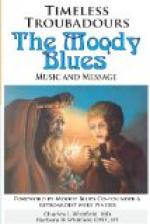are a troubadour commonplace. Many other cases might be quoted. Hymns and songs to the Virgin exhibit the same characteristics of form. The few Provencal words which became English are interesting;[38] colander or cullender (now a vegetable strainer; Prov. colador), funnel, puncheon, rack, spigot, league, noose are directly derived from Provencal and not through Northern French and are words connected with shipping and the wine trade, the port for which was Bordeaux.
In the year 1323 a society was formed in Toulouse of seven troubadours, the “sobregaya companhia,” for the purpose of preserving and encouraging lyric poetry (lo gay saber). The middle class of Toulouse seems at all times to have felt an interest in poetry and had already produced such well-known troubadours as Aimeric de Pegulhan, Peire Vidal and Guillem Figueira. The society offered an annual prize of a golden violet for the best chanso; other prizes were added at a later date for the best dance song and the best sirventes. Competitors found that songs to the Virgin were given the preference and she eventually became the one subject of these prize competitions. The society produced a grammatical [139] work, the Leys d’Amors, under the name of its president, Guillem Molinier, in 1356,[39] no doubt for the reference and instruction of intending competitors. The competition produced a few admirable poems, but anxiety to preserve the old troubadour style resulted generally in dry and stilted compositions. The Academie des jeux floraux[40] altered the character of the competition by admitting French poems after 1694. At the end of the sixteenth century, Provencal poetry underwent a revival; in our own time, poets such as Jasmin, Aubanel, Roumanille and above all, Mistral, have raised their language from a patois to a literary power. The work of the felibres has been to synthetise the best elements of the various local dialects and to create a literary language by a process not wholly dissimilar to that described at the outset of this book. But the old troubadour spirit had died long before; it had accomplished its share in the history of European literature and had given an impulse to the development of lyric poetry, the effects of which are perceptible even at the present day.
BIBLIOGRAPHY AND NOTES
LITERARY HISTORY
F. Diez, Leben und Werke der Troubadours, 2nd edit., re-edited by K. Bartsch, Leipsic, 1882. Die Poesie der Troubadours, 2nd edit., re-edited by K. Bartsch, Leipsic, 1883.
K. Bartsch, Grundriss zur Geschichte der provenzalischen Literatur, Elberfeld, 1872. A new edition of this indispensable work is in preparation by Prof. A. Pillet of Breslau. The first part of the book contains a sketch of Provencal literature, and a list of manuscripts. The second part gives a list of the troubadours in alphabetical order, with the lyric poems attributed to each troubadour. The first line of each poem is quoted and followed by a list of the MSS. in which it is found. Modern editors have generally agreed to follow these lists in referring to troubadour lyrics: e.g. B. Gr., 202, 4 refers to the fourth lyric (in alphabetical order) of Guillem Ademar, who is no. 202 in Bartsch’s list.




